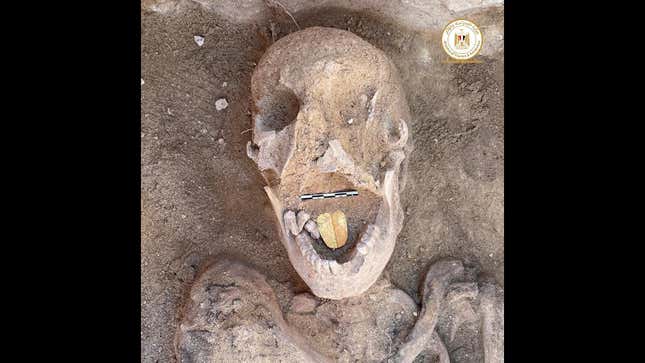
Archaeologists investigating burial shafts near Alexandria, Egypt have discovered over a dozen interred individuals, two of whom still feature golden tongues that were carefully placed inside their mouths.
The rock-cut tombs, found at the Taposiris Magna site in western Alexandria near the Mediterranean coast, date back to the Greco-Roman period (332 BCE to 395 CE). The expedition to investigate these burial shafts is led by archaeologist Kathleen Martinez from the University of Santo Domingo, in what is a joint Egyptian-Dominican mission, according to a statement released on Facebook by the Egyptian Ministry of Tourism and Antiquities.

The team discovered 16 burials inside Taposiris Magna, each of them in an advanced state of degradation and with virtually no soft tissue remaining. Two mummies had amulets of gold foil inside in their mouths as if to emulate their tongues, reports the New York Times. This was likely part of a special funerary ritual to make sure the deceased individuals could “speak in the afterlife” and join Osiris—the god of the afterlife—in their kingdom, according to the ministry.
Speaking to the New York Times, Jennifer Houser Wegner, a curator of Egyptian artifacts at the Penn Museum in Philadelphia, said similar golden tongues have been found before. For the ancient Egyptians, this precious metal “was a material that had qualities of everlastingness,” as gold “never tarnished” and it “always shone brilliantly,” she said.
Importantly, these golden tongues are not to be confused with the practice of placing coins in the mouths of the dead. In this tradition, which lasted for centuries, the coins were meant as a payment to Charon, the ferryman who delivers the dead to the underworld by crossing the river Styx.
In terms of other discoveries, Martinez and her colleagues found a funeral mask adorned with golden flakes shaped like a wreath. Another funeral mask covered the face and body of a woman and included sculpted breasts. The remains of scrolls, busts, and parts of the cartonnage (a material used to form funerary masks) were also found, along with gilded decorations of Osiris. One mummy was wearing a crown adorned with Uraeus—the iconic rearing cobra. The same mummy had a gilded necklace featuring the god Horus, who appears as the head of a falcon.

Speaking through the ministry statement, Khaled Abo El Hamd, director general of the Alexandria Antiquities, said the masks exhibited a high degree of craftsmanship, as evidenced by the depictions of the deceased. Excavations done at Taposiris Magna over the past 10 years have “changed our perception” of the temple, the ministry statement said, including evidence that the structure was built by King Ptolemy IV.
For Martinez, her ultimate goal is to find Cleopatra’s burial site; Martinez has devoted her life’s work to the search, and her team has spent the last 14 years on the hunt. The famous queen, who ruled ancient Egypt from her throne in Alexandria, is believed to have died by suicide and been buried at Taposiris Magna. The search for Cleopatra’s elusive remains continues.